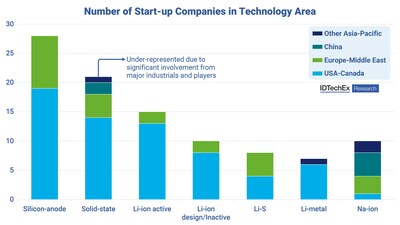BOSTON, April 17,
2024 /PRNewswire/ -- IDTechEx forecast the market for
lithium-ion (Li-ion) battery cells to be worth US$380 billion by 2034, driven by advancements in
technology and rapidly growing demand. While Li-ion batteries have
been the dominant technology for electronic devices, electric
vehicles (EV), and stationary energy storage systems, alternative
battery technologies and chemistries continue to garner interest.
For example, over the past four years, sodium-ion (Na-ion)
batteries have emerged as a competitor, poised to capture market
share amid concerns over cost and material supply. Additionally,
various other battery chemistries, including redox flow, metal-air,
and thermal energy storage technologies, are being explored for
stationary and industrial energy storage applications. However,
despite the emergence of alternatives, Li-ion chemistries are
expected to maintain their dominance, fuelled by ongoing
advancements that enhance performance and drive down costs.
IDTechEx's latest report, "Advanced Li-ion Battery Technologies
2024-2034: Technologies, Players, Forecasts", analyses the
range of technological innovations and advancements being developed
for the next-generation of Li-ion batteries.

Key avenues for improving Li-ion performance stem from changes
to the anode and cathode materials as well as optimizations in cell
design, electrolyte formulation, changes in current collector
design, and improvements to battery management systems. Energy
density remains one of the most important performance
characteristics as an enabler of longer range EVs, longer device
runtimes, and for enabling new applications such as eVtol aircraft.
With the current iteration of Li-ion designs reaching their energy
density limits, there is considerable interest in anode materials
like silicon and lithium-metal, which offer the potential for
significant increases in lithium storage capacity and, therefore,
energy density over batteries using graphite as the anode material.
Beyond energy density, battery manufacturers and automotive OEMs
are also increasingly focused on improving fast charge capability.
Here, silicon-based anodes can also hold an advantage over
graphite, with numerous companies advertising and starting to
demonstrate the possibility of reaching 10-minute fast charge
capability. These performance benefits will be useful not only for
electric cars and vehicles but also for other applications,
including consumer devices, power tools, drones, and military
applications.
Solid-state batteries also continue to garner significant
interest as one of the most promising next-generation battery
technologies due to their ability for safer operation, an issue of
increasing concern to the industry and consumers. Improvements to
energy density are also possible with solid electrolyte technology
as it can help enable the use of high-energy lithium metal
anodes.
On the cathode front, efforts are focused on optimizing the
balance between performance and cost. For example, materials such
as lithium manganese iron phosphate (LMFP) and
lithium-manganese-rich (Li-Mn-rich) layered oxides are being
developed to bridge the gap between lower-cost LFP and
higher-energy, high-nickel NMC and NCA cathode materials.
Innovations to how cathode active materials (CAM) are synthesized
are also being explored to reduce cell costs and minimize the
environmental impact of cathode and battery production, issues that
will only become more important. Barriers still exist before the
widespread deployment of advanced anode, cathode, and electrolyte
materials, but improvements to battery technology will be key to
enabling the mass adoption of EVs and opening up new applications
and markets such as electric and eVtol aircraft.
Meanwhile, the geographical dynamics of the Li-ion battery
market are evolving. While Asia
currently dominates the value chain, regions like the US and
Europe are ramping up efforts to
develop their own battery supply chains, leveraging innovation and
next-generation technology development. The US is home to numerous
startups dedicated to advancing and commercializing next-generation
Li-ion technology. Government initiatives, such as the Inflation
Reduction Act and funding provided by the Bipartisan Infrastructure
Law, are further catalyzing innovation and investment. For example,
companies like Sila Nano and Group14
Technologies are deploying available funding and investment to
develop commercial-scale manufacturing capabilities for advanced
silicon anode materials. While Asia remains a powerhouse in battery
manufacturing and materials production, efforts in the US and
Europe to cultivate domestic
supply chains and foster innovation offer a pathway to
competitiveness. The future of the Li-ion battery market will be
shaped by ongoing technological advancements, geographical shifts
in production, and the race to capture value in this rapidly
expanding industry.
To find out more about the IDTechEx report "Advanced Li-ion
Battery Technologies 2024-2034: Technologies, Players,
Forecasts", including downloadable sample pages, please visit
www.IDTechEx.com/AdvLithium. IDTechEx's latest report and
subscription platform provides the data and analysis to keep up to
date with the latest trends and innovations in battery
technology.
To find out more about the portfolio of batteries and energy
storage market research from IDTechEx, please see
www.IDTechEx.com/Research/ES.
Upcoming free-to-attend webinar
Exploring the World of Li-ion Battery Technology
Advancements
Dr Alex Holland, Research
Director at IDTechEx and author of this article, will be presenting
a free-to-attend webinar on the topic on Wednesday 15 May 2024 - Exploring the World of Li-ion
Battery Technology Advancements.
This webinar will cover:
- Next generation anode materials such as silicon, lithium and
anode-free designs
- Innovations in cathode active materials and their
manufacture
- Important cell and pack design changes and trends
- Key cost and resource consideration from advanced Li-ion
battery chemistries
- IDTechEx's outlook for advanced Li-ion technology
Please click here to check timings and register for your
specific time zone.
If you are unable to make the date, please register anyway to
receive the links to the on-demand recording (available for a
limited time) and webinar slides as soon as they are available.
About IDTechEx:
IDTechEx provides trusted independent research on emerging
technologies and their markets. Since 1999, we have been
helping our clients to understand new technologies, their supply
chains, market requirements, opportunities and forecasts. For more
information, contact research@IDTechEx.com or
visit www.IDTechEx.com.
Image
download:
https://www.dropbox.com/scl/fo/50bioq0vemmezslvzb9op/h?rlkey=ogmv62a43m64m39cr22ee21kq&dl=0
Media Contact:
Lucy Rogers
Sales and Marketing Administrator
press@IDTechEx.com
+44(0)1223 812300
Social Media Links:
Twitter: www.twitter.com/IDTechEx
LinkedIn: www.linkedin.com/company/IDTechEx
Photo -
https://mma.prnewswire.com/media/2386750/IDTechEx_Li_ion.jpg
Logo -
https://mma.prnewswire.com/media/478371/IDTechEx_Logo.jpg
 View original content to download
multimedia:https://www.prnewswire.com/news-releases/advancements-and-competition-key-factor-behind-idtechexs-us380b-li-ion-forecast-302116546.html
View original content to download
multimedia:https://www.prnewswire.com/news-releases/advancements-and-competition-key-factor-behind-idtechexs-us380b-li-ion-forecast-302116546.html
SOURCE IDTechEx